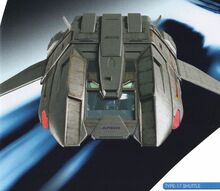Type-17 Shuttlecraft
From Star Trek: Theurgy Wiki
 The copyright of this image belongs to Eaglmoss Collections. Its use is contended to be consistent with fair use rules under United States copyright law.
| ||
| Name: | Type-17 Shuttlecraft | |
| Ship Type: | Auxiliary Support Craft | |
| Production Status: | Ongoing | |
| Role: |
| |
| Constructed: | 2379-present | |
| Dimensions: |
| |
| Mass: | 73.5 metric tons | |
| Standard Crew Complement: |
| |
| Warp Speeds: | ||
| Tactical Specs: |
| |
| Defensive Specs: |
| |
| Other Systems |
| |
| Other Standard-issue Equipment |
|
|
The Type-17 shuttlecraft or Argo-class, was a 24th century Federation auxiliary craft, a heavy cargo shuttle/cargo shuttle/heavy transport shuttlecraft issued to certain Starfleet ships and starbases throughout the 2370s. By 2381, the Type-17 shuttlecraft had become ubiquitous throughout the Federation as one of the largest and most capable transport craft in any starship's inventory, with one Type-17, the Tesla being delivered to the USS Theurgy.
Production History
In 2379, a new type of cargo shuttle was assigned to the Enterprise-E, complete with an all-terrain vehicle.
The Argo was a Type-17 heavy transport, or cargo, shuttlecraft of the kind that was attached to Sovereign-class starships, such as the U.S.S. Enterprise NCC-1701-E, from 2379 onwards. At the time the shuttle was considered to be the most advanced of the type and it was field-tested during its very first mission -transporting Captain Jean-Luc Picard, Commander Data, and Commander Worf to the surface of Kolarus III.
Propulsion Systems
The Type-17 had both warp and impulse engines. The warp nacelles had a conformal design that contained them entirely within the body of the shuttle. This model of the shuttle had a 2.250 millicochrane engine and could maintain a cruising spd of Warp 1.65. RCS thrusters were used to control its direction in atmospheric flight and to ensure a soft landing.
Tactical Systems
Auxiliary Vehicle
The Type-17 was officially classed as a cargo shuttle and was assigned to transport a variety of materials. It was accessed from a large hatch in the rear, which allowed the crew to load substantial amounts of cargo. Crew members could walk through the cargo area to the pilot's cabin. In one configuration it carried an all-terrain multipurpose utility vehicle or MUV, a wheeled vehicle, which was designed to operate on a planet's surface. The MUV, known as the 'Rover', exited the shuttle through the rear hatch, which folded down to allow it to drive out onto the surface. The MUV was considered to be 'part of' the shuttle and shared its name.
The MUV had an open cockpit and tubular framework. It also featured big, off-road tires to deal with the roughest terrain. The MUV was armed with a heavy-duty phaser cannon, which was mounted at the rear and operated by a rear-seated passenger. Typical of most off-road vehicles, the MUV featured a soft suspension enabling it to maneuver around, sometimes balanced on just two wheels, and to climb very rocky or tough terrain, while at the same time providing the driver and passengers with as comfortable a ride as possible.
While on the ground the MUV remained connected to the shuttle by a hand-held remote control unit that was kept alongside a scanner on the dashboard. This made it possible for a member of the away team to pilot the shuttle remotely. The shuttle could actually be launched and flown from the MUV. This did away with the need to leave a crew member manning the shuttle, while at the same time, enabling the away teams to bring the shuttle to wherever they happened to be in the event that the shuttle was compromised, or a quick getaway was needed.
Onboard the shuttle, the MUV was held firmly in place with a set of wheel clamps situated in the cargo bay. These clamps would automatically engage the vehicle, firmly holding it in place. This was essential when the MUV had to enter the shuttle while it was in flight.

